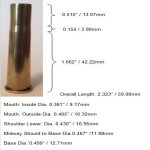First off, to dispel any erroneous presumptions: I am talking about the orginal .45-75 bottleneck WCF cartridge - not the straight walled .45-70. That is NOT a misprint! 
My problem is that I bought one of those Uberti 1876 lever gun reproductions in this caliber - and brass is either insanely expensive, or not available at all. Are there any shade-tree obsolete ammo makers in Canada that can furnish this stuff at a half-sane price? If not... I will have to make it myself, but would have to invest in a mini-lathe and fab the cases from a parent caliber. Has anybody done that? Is it worthwhile
Any info or thoughts you might have are sincerely appreciated. Are their other obsolete calibres a guy could make like this?
My problem is that I bought one of those Uberti 1876 lever gun reproductions in this caliber - and brass is either insanely expensive, or not available at all. Are there any shade-tree obsolete ammo makers in Canada that can furnish this stuff at a half-sane price? If not... I will have to make it myself, but would have to invest in a mini-lathe and fab the cases from a parent caliber. Has anybody done that? Is it worthwhile
Any info or thoughts you might have are sincerely appreciated. Are their other obsolete calibres a guy could make like this?















































































